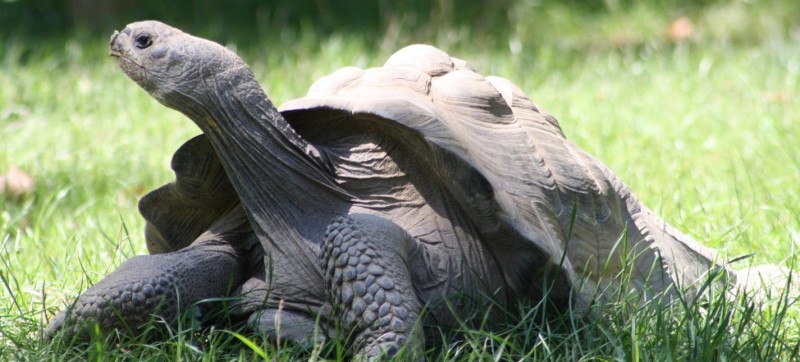Galapagos Tortoise - Gechelone nigra



Habitat:
On the wetter islands, the tortoises migrate down gentle mountain slopes after the wet season to feed on the grass-covered plains. In the dry season they climb back up to feed on grasses of the mountain meadows
Range:
Native to seven islands of the Galapagos archipelago
Activity Cycle:
Being cold-blooded, the tortoises bask for two hours after dawn, absorbing the energy through their shells, then becoming active for 8-9 hours a day. They may sleep for about sixteen hours in a mud wallow partially or submerged in rain-formed pools
Features:
The tortoises have very large shells (carapace) made of bone. When threatened, it can withdraw its head, neck and forelimbs into its shell for protection, presenting a protected shield to a would-be predator. The legs have hard scales that also provide armor when withdrawn. Tortoises keep a characteristic scute pattern on their shell throughout life. These have annual growth bands but are not useful for aging as the outer layers are worn off. There is little variation in the dull-brown color of the shell or scales
Size:
Fully grown adults can weigh over 661 lb and measure 4 ft long.
Social Structure:
Found in large herds
Diet:
The tortoises are herbivorous animals with a diet comprising cactus, grasses, leaves, vines, and fruit. Fresh young grass is a favorite food of the tortoises, and others are the 'poison apple', the endemic guava, the water fern, and the bromeliad.
Reproduction:
Mating occurs at any time of the year, although it does have seasonal peaks between January and August. The male sniffs the air when seeking a female, bellows loudly, and bobs his head. The male then rams the female with the front of his shell and bites her exposed legs until she withdraws them, immobilizing her. After mating (June-December), the females journey up to several kilometers to reach nesting areas of dry, sandy ground (often near the coast). Nest digging can last from hours to days and is elaborate and exhausting. The young emerge from the nest after 120 to 140 days gestation.
Status:
Listed as endangered in wild. Reintroduction efforts exist to rebuild the populations throughout the islands due to man’s harmful influence. They are also part of an AZA Species Survival Plan.
Interesting Facts:
- Temperature plays a role in sex determination of young
- Up to 250,000 tortoises inhabited the islands when they were discovered. Today only about 15,000 are left.
- Very vocal creatures making grunts and whistles during the day

AZA cooperatively manages this species as a Species Survival Plan® Program.
Video:
Prices
- Adult (13 and over)$12.50
- Child (2 - 12)$9.00
- Child (1 and Under)FREE
- Senior (65+)$11.50
- Active Military$11.50
We begin transferring animals to evening (off exhibit) holding at 4:30 each night.
Find Us
2320 N. Prospect Rd.
Peoria, IL 61603
Phone: 309-686-3365
Open Daily 10:00-5:00
Last admission at 4:30
